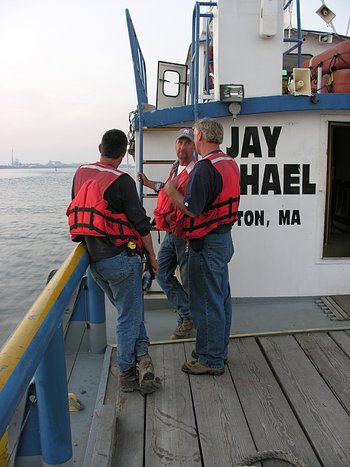November 8, 2005:
Building a Reef - with surgical skill
Reef building consists of transporting reef segments from the Navy
yard to a site designated by the Division of Natural Resources. The
Cashman/Testa team has been havesting reef segments with wreckless abandon
for the past several months. This afternoon, I got to watch this very
delicate surgical procedure - a new technique in transplantation

and to keep the work context clear - we are preparing to transport
the reef segments to their new home, while in the distance, barge loading
for another reef transplant procedure is well under way

I took a small GPS along to track our course. From the tracks, you can
see the Captain Bill's outbound and inbound routes deviated
no more than a few feet.

Team members Rick Beauchamp, Brad Kenerson and Kenny King -
as we pass under the Pearman skeleton


with Charleston's new Ravenel Bridge trailing

and Capt. Bill being a captain

About an hour later - our target - a barge, Brad's 345 and Rick's 750

and a bit closer - illustrating our surgical instruments in the sleeping
configuration.

Backing up a bit - to transplant a reef segment, segments must first be
harvested - as shown here - harvesting a concrete girder over East Bay.
Successful transplantation requires timely harvesting, transport and
repositioning. These girders were harvested Nov 2 night, when the temperature
was low and girder spoilage was minimized. This
girder was being parked on the Pearman ramp to the left

where it was divided into three precisely equal segments - perfect
for reef transplantation.

Back to the main story, here
Rick and Brad hop on the barge and immediately, Rick opens his jaws

Here seen in the operator position

Not to be out done - Brad opens his jaws also

and a closer view of Brad in his operator position

We continuously circle the barge, picking up floating debris - and so
I had some fun playing with different lighting angles from the sun - here
a silhouette of an open jaw.

with Capt. Bill looking on

Here is the basic reef transplant procedure - first someone has to be
King of the Mountain

Brad picks up a to-be-transplanted-reef-segment with his 345's jaws

Gently lets go

and the transplantion process is now activated

There is an initial splash

then as it subsides - Mike pointed out that the 2nd wave is almost
always taller than the first - some interesting physics here! - Anyone
have any ideas?

The large secondary wave, the water returns to its calm state and
the next transplant cycle is initiated.

For those with high speed internet access here is a video (40 Mb quicktime mov)
of Rick and Brad in action.
Here is Rick demonstrating his transplant skills

Note the secondary splash

Rick likes to show his jaws, though -

and of course - takes two to tango

and the tango has many different variants

but only one to make a splash

I still enjoy watching "Clash of the Titans"

Finishing up - a short conversation and then

All surgeons spend a bit of time in the surgical lounge - sort of mental
unwinding after a difficult transplant procedure
 Mike offers a few suggestions
Mike offers a few suggestions

and then the sun did its setting thing - with a sail boat made to order

and finally Charleston where the sun says goodbye and we are home


